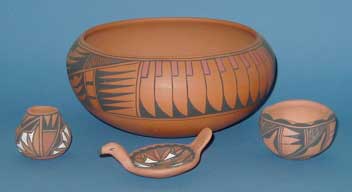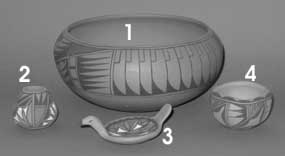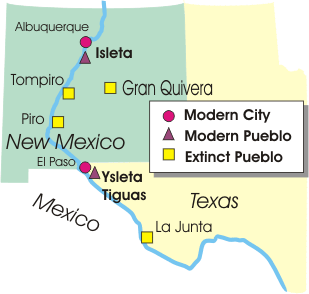 ClayHound Web
- Ysleta del Sur
Pottery
ClayHound Web
- Ysleta del Sur
PotteryReturn to:
|
Ysleta del Sur Pueblo is located in El Paso, Texas. |
|
|
|
|
|
|
|
|
The Tigua of Ysleta del Sur Pueblo The Tigua are the only Puebloan tribe still in Texas. Other Puebloan tribes in Texas include the long gone prehistoric Pueblos along the Canadian River in the Texas Panhandle and probably the Jumano. They called their ancestral home Pueblo Gran Quivera. It was located north of El Paso in the Manzano Mountains - southeast of Albuquerque - and was started about A D 800. By 1300 it was one of the largest Pueblos.
In the 1600s more Spanish came and founded missions and settlements in New Mexico around Gran Quivera. With the Spanish came diseases and epidemics that killed many of the Pueblo Indians including the Tigua of Gran Quivera. The Spanish also would take Pueblo Indians to act as slaves in their settlements. In the 1670s there was a bad drought that lasted several years. Food was in short supply. The population of Gran Quivera dwindled and got smaller and smaller. By 1675 they were desperate so they left. They went south to the Rio Grande River near modern El Paso. They settled there and started farming. Some of the Tigua went north to live with their close relatives at Isleta Pueblo. The Isleta Puebloans spoke Tiwa like the Tigua. Gran Quivera was left abandoned. The ruins are still there and are protected by the National Park Service. In 1680 all the Pueblo Indians revolted against the Spanish. They drove the Spanish out of New Mexico and down to El Paso. In 1681 Spanish came back and attacked Isleta Pueblo. Many of the Isleta Puebloans managed to run away and escape. But, the Spanish captured many of them. The Spanish forced these Isleta Pueblo prisoners to come with them to El Paso. These were both Isleta Puebloans and Tiguas. The Isleta Indians who ran away did come back to their Pueblo and made peace with the Spanish. Isleta Pueblo is still there today and the Isleta Pueblos still live there on the pueblo. In 1682 the Tigua and Isleta near El Paso founded Ysleta. Ysleta is a different way of spelling Isleta which they did to avoid confusion with Isleta. By this time they had become Christians and built a mission church. The Ysleta mission is the oldest church in Texas and the oldest mission in Texas. The Spanish King gave the Indians of Ysleta a grant around their Pueblo which gave them title to the land. The Ysleta mission and the Pueblo were right next to the expanding town of El Paso. Eventually the Tigua were living as a suburb of El Paso. The still live there today. Their neighborhood is called in Spanish "El barrio de los Indians". After the Americans took over in 1848 of crooked land speculators stole much of the Tigua land from them. The State of Texas ignored the Tigua's Spanish land grant and title to the land. Much of present day El Paso is built on land taken from the Tigua. This left the Tigua very poor. Only the land around the Ysleta mission and their houses was still theirs. By the 1930s many people thought the Tigua were extinct. But they were not. In the 1960s they began asserting themselves and laying claim to the land they had lost. In 1968 Texas finally recognized the Tigua as a tribe. Later in 1968 Lyndon Johnson signed an act of the U S Congress recognizing the Tigua as a tribe and making their land a reservation. This is where the Tigua live today. |
|


 The Spanish explorer
Coronado was the first European to see Gran Quivera in 1539. The
Spanish called it "Pueblo de los Humanas", which means "city of the
humans".
The Spanish explorer
Coronado was the first European to see Gran Quivera in 1539. The
Spanish called it "Pueblo de los Humanas", which means "city of the
humans".